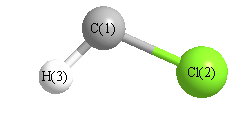Jump to
S2C1
Energy calculated at CCSD=FULL/cc-pVQZ
| | hartrees |
|---|
| Energy at 0K | -498.331203 |
| Energy at 298.15K | -498.331075 |
| HF Energy | -497.860595 |
| Nuclear repulsion energy | 38.933690 |
The energy at 298.15K was derived from the energy at 0K
and an integrated heat capacity that used the calculated vibrational frequencies.
Geometric Data calculated at CCSD=FULL/cc-pVQZ
Point Group is Cs
Cartesians (Å)
| Atom |
x (Å) |
y (Å) |
z (Å) |
|---|
| C1 |
0.045 |
1.186 |
0.000 |
| Cl2 |
0.045 |
-0.502 |
0.000 |
| H3 |
-1.031 |
1.425 |
0.000 |
Atom - Atom Distances (Å)
| |
C1 |
Cl2 |
H3 |
| C1 | | 1.6880 | 1.1022 |
Cl2 | 1.6880 | | 2.2069 | H3 | 1.1022 | 2.2069 | |
 More geometry information
More geometry information
Calculated Bond Angles
| atom1 |
atom2 |
atom3 |
angle |
|
atom1 |
atom2 |
atom3 |
angle |
| Cl2 |
C1 |
H3 |
102.513 |
|
Electronic energy levels
Charges, Dipole, Quadrupole and Polarizability
Jump to
S1C1
Energy calculated at CCSD=FULL/cc-pVQZ
| | hartrees |
|---|
| Energy at 0K | -498.325854 |
| Energy at 298.15K | -498.325711 |
| HF Energy | -497.885071 |
| Nuclear repulsion energy | 39.208729 |
The energy at 298.15K was derived from the energy at 0K
and an integrated heat capacity that used the calculated vibrational frequencies.
Geometric Data calculated at CCSD=FULL/cc-pVQZ
Point Group is Cs
Cartesians (Å)
| Atom |
x (Å) |
y (Å) |
z (Å) |
|---|
| C1 |
0.036 |
1.146 |
0.000 |
| Cl2 |
0.036 |
-0.510 |
0.000 |
| H3 |
-0.827 |
1.790 |
0.000 |
Atom - Atom Distances (Å)
| |
C1 |
Cl2 |
H3 |
| C1 | | 1.6559 | 1.0764 |
Cl2 | 1.6559 | | 2.4560 | H3 | 1.0764 | 2.4560 | |
 More geometry information
More geometry information
Calculated Bond Angles
| atom1 |
atom2 |
atom3 |
angle |
|
atom1 |
atom2 |
atom3 |
angle |
| Cl2 |
C1 |
H3 |
126.713 |
|
Electronic energy levels
Charges, Dipole, Quadrupole and Polarizability
